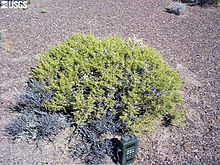Sarcobatus
| Sarcobatus | |
|---|---|

| |
| S. baileyi | |
| Scientific classification | |
| Kingdom: | Plantae |
| Clade: | Tracheophytes |
| Clade: | Angiosperms |
| Clade: | Eudicots |
| Order: | Caryophyllales |
| Family: | Sarcobataceae Behnke |
| Genus: | Sarcobatus Nees |
| Species | |
|
See text | |
| Synonyms[1] | |
| |
Sarcobatus is a North American genus of two
Name
In
Description


The Sarcobatus plants are
Habitat
The Sarcobatus area of distribution is western North America, from southeastern British Columbia and southwest Alberta, Canada south through the drier regions of the United States (east to North Dakota and west Texas, west to central Washington and eastern California) to northern Mexico (Coahuila).
Both Sarcobatus species are halophytes, usually found in sunny, flat areas around the margins of playas and in dry stream beds and arroyos. While it tolerates salty soil (storing absorbed salt in the roots and leaves),[3] it is replaced by iodine bush in extremely saline environments, such as hummocks within the playa itself. Greasewood often grows in alkaline flats (being a reliable indicator of alkaline soil)[3] and in extensive, nearly pure stands in pluvial desert locations, being most common on fine-grained soils in areas with a relatively high water table.
Uses
Although it can be grazed by animals that are adapted, grazing of greasewood by sheep and cattle can result in
The wood is yellow, very hard and tough.[6] Because it is so hard, it was used as a shaft for arrows.[7] It was also used as firewood by Native Americans and early settlers. They are used traditionally by Navajo as stirring sticks, Ádístsíín.[citation needed]
Taxonomy
These plants were formerly treated in the family
Species
The two species are:
- Sarcobatus baileyi
- Sarcobatus vermiculatus (Hook.) Torr. Throughout the range of the genus. Plants are generally 1–2 metres high, although some up to 5 metres high have been recorded.[2] Leaves hairless or only slightly hairy, 15–40 mm long. Synonyms include:[2]
- Batis vermiculata Hooker
- Fremontia vermiculata (Hooker) Torrey
- Sarcobatus maximilianii Nees
References
- ^ a b c d Matthew H. Hils, John W. Thieret & James D. Morefield. "Sarcobatus". In Stanley L. Welsh; Clifford W. Crompton; Steven E. Clemants (eds.). Flora of North America, volume 4, Chenopodiaceae.
- ^ a b c Matthew H. Hils, John W. Thieret & James D. Morefield. "Sarcobatus vermiculatus". In Stanley L. Welsh; Clifford W. Crompton; Steven E. Clemants (eds.). Flora of North America, volume 4, Chenopodiaceae.
- ^ OCLC 25708726.
- ^ "Lewis and Clark as naturalists". Smithsonian National Museum of Natural History.
- ^ A. P. Knight & R. G. Walter (10 January 2020). "Plants Causing Kidney Failure" (PDF). In A.P. Knight & R.G. Walter (eds.). A Guide to Plant Poisoning of Animals in North America. Teton NewMedia, Jackson WY (www.veterinarywire.com) and International Veterinary Information Service (www.ivis.org), Ithaca, New York, USA.
- ^ Rines, George Edwin, ed. (1920). . Encyclopedia Americana.
- ^ Kathy Lloyd & Carole Mackin. "Sarcobatus vermiculatus: Greasewood". Montana Native Plant Society. Retrieved 14 February 2016.
- ^ Stanley L. Welsh; Clifford W. Crompton & Steven E. Clemants (2004), "Chenopodiaceae Ventenat", Flora of North America, vol. 4
- JSTOR 1224390
- JSTOR 1223929
- PMID 25837578
- ^ a b Matthew H. Hils; John W. Thieret; James D. Morefield. "Sarcobatus baileyi". In Stanley L. Welsh; Clifford W. Crompton; Steven E. Clemants (eds.). Flora of North America, volume 4, Chenopodiacea e.
External links
- Jepson Flora: Sarcobatus vermiculatus
- Extensive description with images explorenm.com, Explore New Mexico
- USDA PLANTS Database
- Canadian Poisonous Plants Information System, Notes on poisoning: Sarcobatus vermiculatus
- Oregon State University, Malheur Agricultural Experiment Station
- Sarcobataceae in L. Watson and M.J. Dallwitz (1992 onwards). The families of flowering plants: descriptions, illustrations, identification, information retrieval. Version: 30 May 2006. http://delta-intkey.com
- NCBI Taxonomy Browser
